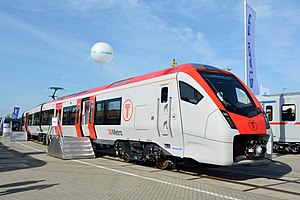
Summary
The British Rail Class 756 FLIRT[7] is a class of tri-mode multiple units being built for Transport for Wales Rail by Swiss rolling stock manufacturer Stadler Rail. They are closely related to the Class 755 bi-mode units delivered by Stadler to Greater Anglia between 2018 and 2020, which can be powered either by overhead electric lines or on-board diesel generators. The Class 756 units will also carry batteries as an additional source of traction power.[8]
| British Rail Class 756 FLIRT | |
|---|---|
 | |
| In service | Planned for 2024[1] |
| Manufacturer | Stadler Rail |
| Assembly | Stadler Bussnang AG |
| Built at | Bussnang, Switzerland[2] |
| Family name | FLIRT |
| Replaced | |
| Constructed | 2021–2023[3] |
| Number under construction | 24 (7 × 3-car, 17 × 4-car) |
| Formation | |
| Fleet numbers |
|
| Capacity |
|
| Owners | SMBC Leasing[4] |
| Operators | Transport for Wales Rail |
| Depots | Canton (Cardiff) |
| Specifications | |
| Car body construction | Aluminium |
| Train length |
|
| Width |
|
| Height | 3.915 m (12 ft 10.1 in) |
| Floor height | 960 mm (3 ft 2 in) |
| Doors | Double-leaf sliding plug, each 1.300 m (4 ft 3.2 in) wide (total 5 per side per 3-car, 7 per side per 4-car) |
| Wheel diameter |
|
| Wheelbase | Bogies: 2.700 m (8 ft 10.3 in) |
| Maximum speed | 75 mph (121 km/h) |
| Traction system | IGBT |
| Power output |
|
| Tractive effort | Maximum starting: 200 kN (45,000 lbf) |
| Acceleration | Maximum starting: 1.1 m/s2 (2.5 mph/s) |
| Electric system(s) | 25 kV 50 Hz AC overhead |
| Current collector(s) | Pantograph |
| UIC classification |
|
| Safety system(s) | |
| Multiple working | Within class (max. 2 units) |
| Track gauge | 4 ft 8+1⁄2 in (1,435 mm) standard gauge |
| Notes/references | |
| Sourced from [6] unless otherwise noted. | |
A total of 24 units are to be built, split between 7 three-car units and 17 four-car units.[6]
History edit
The Wales & Borders rail franchise, awarded to KeolisAmey Wales with effect from 14 October 2018, included a commitment requiring that the operator oversee a full fleet replacement during the franchise period.[9] As part of this process, KeolisAmey placed an order with Stadler in February 2019 for the 24 FLIRT tri-mode units that came to be designated Class 756. The tri-mode capabilities are intended to facilitate operations over lines that have only been partially electrified. Production of the fleet was underway by mid-2021,[2] and entry into service is planned for 2024.[1]
Operators edit
Transport for Wales edit
When built, Transport for Wales Rail Class 756 units will operate services on the Rhymney line and Vale of Glamorgan Line.
Technical details edit
Class 756 units have three or four passenger vehicles, along with a separate "Power Pack" vehicle near the centre of the unit that contains a diesel generator set and three battery modules.[10] The diesel generator produces 480 kW (640 hp), while the batteries are capable of supplying up to 1,300 kW (1,700 hp).[6] All vehicles are linked by unpowered Jacobs bogies, while the outermost bogie at each end of each unit carries the traction motors.[6]
Fleet details edit
| Subclass | Operator | Qty. | Year built | Passenger cars | Unit nos.[3] |
|---|---|---|---|---|---|
| 756/0 | Transport for Wales Rail | 7 | 2021–2023 | 3 | 756001–756007 |
| 756/1 | 17 | 4 | 756101–756117 |
Illustration edit
Notes edit
References edit
- ^ a b "Tfw confirms Class 756 introduction for this year". Headline News. Rail Express. No. 334. March 2024. p. 11.
- ^ a b "Testing Begins on New FLIRTs for TfW". Railvolution. Praha: Railway Public s.r.o. 29 July 2021. Archived from the original on 2 August 2021. Retrieved 27 December 2022.
- ^ a b c Pritchard, Robert (2022). British Railways Pocket Book No. 4: Electric Multiple Units (36th ed.). Sheffield: Platform 5 Publishing. pp. 132–133. ISBN 978-1-909-43183-6.
- ^ "Time to take stock as the 'bubble' bursts…". Rail Magazine. No. 989. 9 August 2023. pp. 42–47.
- ^ Bi-Mode Multiple Unit - FLIRT - Greater Anglia, UK (PDF). Bussnang: Stadler Rail Group. 27 August 2018. FEABMU0819e. Archived (PDF) from the original on 29 October 2023. Retrieved 1 August 2019.
- ^ a b c d FLIRT Trimodal Multiple Unit - Transport for Wales (PDF). Bussnang: Stadler Rail Group. 6 September 2022. FWBBMU0922e. Archived (PDF) from the original on 29 October 2023. Retrieved 3 December 2020.
- ^ Transport for Wales Rail [@tfwrail] (2 December 2019). "Lastly, our innovative tri-mode Metro trains which will enter service on the Rhymney, Coryton & Vale of Glamorgan lines in 2023, will be Class 756" (Tweet) – via Twitter.
- ^ "What's Happening in South East Wales". Transport for Wales. Archived from the original on 14 October 2018. Retrieved 30 September 2018.
- ^ "KeolisAmey reveal new-look Wales trains and services". BBC News. British Broadcasting Corporation. 4 June 2018. Retrieved 4 June 2018.
- ^ Fender, Keith; Sherratt, Philip (20 September 2022). "Stadler shows trains for the UK at InnoTrans". Modern Railways. Stamford: Key Publishing. Archived from the original on 20 September 2022. Retrieved 27 December 2022.


